The term “weight” could be defined as phonological weight (number of syllables) or syntactic weight (number of words). In this section, “weight” is defined as syntactic weight. According to the principle of end-weight, a long possessor favors the of-genitive. Rosenbach (2013: 284) notes that weight is not an “absolute notion”, but it refers to the relative weight of possessor and possessum. Compare the following two examples: (1) John’s new book, (2) the old king’s young and very beautiful wife (Rosenbach 2013: 284). Although the possessor the old king in example (2) is longer than the possessor John in example (1), it is relatively shorter than its possessum young and very beautiful wife.

Rosenbach (2013) studied the influence of weight on the genitive through a corpus analysis. The results are shown below:
Figure 3a. Weight of the possessor with human possessors in the ICE-GB: relative frequency of the s-genitive and the of-genitive (number of tokens indicated above each column) (Rosenbach 2013: 290)

Figure 3b. Weight of the possessor with inanimate possessors in the ICE-GB: relative frequency of the s-genitive and the of-genitive (number of tokens indicated above each column) (Rosenbach 2013: 290)
In figure 3a, the percentage of of-gentives rises with an increasing word number of animate possessors (up to 3 premodifiers), although in this case the s-genitive is still preferred. In contrast, in figure 3b, when the possessors are inanimate, ranging from 1 word to 5 words, the of-genitive dominates. Yet the result is insufficient to support the principle of end-weight, because it restricts the data to animate and inanimate possessors, and animacy has a bigger effect on the choice of genitive than weight (as will be mentioned in the following chapter). Hence it is also necessary to look at the results provided by Hinrichs and Szmrecsanyi (2007). See table 1a and 1b:

Table 1a. Mean possessor length by corpus and genitive type (Hinrichs and Szmrecsanyi 2007: 454)

Table 1b. Mean possessum length by corpus and genitive type (Hinrichs and Szmrecsanyi 2007: 455)
In this study, only the length of possessor and possessum is taken into account, so that the influence that might be caused by other factors could be avoided. It is not difficult to see in table 1a that the average length of s-genitive possessors is 1.81, while the average length of of-genitive possessors is 2.71. In table 1b, the average length of s-genitive possessums is 1.76; the corresponding figure for of-genitive possessums is 1.51. These two tables also show a historical development of the length of possessors and possessums in both genitive types. The average length of s-genitive possessors has decreased from the 1960s (Brown and LOB) to the 1990s (Frown and F-LOB), and the average length of s-genitive possessums has increased during the same period. Also, of-genitive possessors have become longer during this time, and the possessums in the of-genitive have become shorter.
In the recent study by Szmrecsanyi, Rosenbach, Bresnan and Wolk (2014: 141), it has been observed that, “medium-length possessums are not as unexpectedly hostile towards the s-genitive as in earlier ARCHER (1650 - 1875) texts”, and the effect of possessor length is less apparent in American English than in British English.
Created with the Personal Edition of HelpNDoc: Full featured Help generator